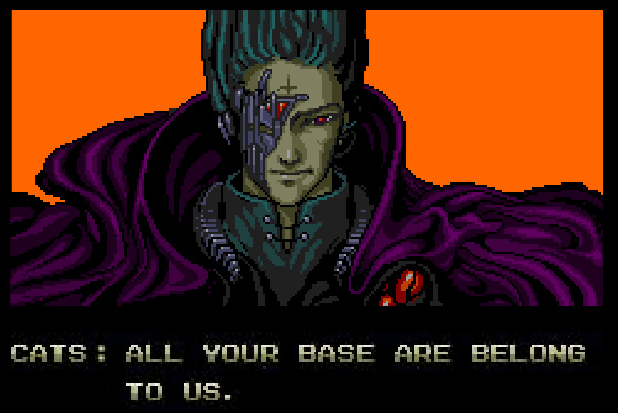Every few weeks for the last three months, I’ve received a type of email that I hate to get. The emails all contain a message like, “I think you have a typo on your site.”
The first time I got a mail like this, I went into full response mode . You know the feeling – elevated heart rate, embarrassment, self-castigation, etc.

But on a re-read of the mail, I realized what the sender flagged wasn’t a typo at all. Rather, it was an inside joke, a meme to be specific – a reference the reader didn’t get.
Allow me a brief pause to share the “typo” pointed out by our visitor. It is an in-page headline on our site introducing a matrix of social channels we analyze in our product.

The headline was a play on the “all your base” meme, born of a bad translation from the 1991 video game, Zero Wing. You can find “all your base” in everything from signs to EDM remixes and more. “All your base” is a common meme in the programming world. Yet, I’ve learned that isn’t the case among marketing professionals.

A few weeks after the first mail, I got a second from a site visitor telling me, again, that I might have a typo on my website. Eventually, a third mail came. And a fourth.
Finally, I received an email from a former colleague. She, too, had found my “typo.”

Now that I had the attention of someone whose opinion I trust, I took the opportunity to explain.

I should have expected her concise response, but somehow, I didn’t.

Somehow, her point seemed so obvious when surrounded by so much whitespace. Of course the reference is obscure!
I spend considerable time thinking about my audience. Yet, I’m usually thinking about what they do at work. At least in this case, I’d forgotten to think about my audience in a broader sense, as the whole people they are. #MarketingFail
How Did That Reference End Up on Your Site, Anyway?
Let me back up for a second. As a founder of Rival IQ, I’ve had either one or both hands into our marketing efforts from day one. I like to think that we’re fun, witty people, and I want our brand to feel fun and witty, too.
I don’t dedicate enough time to ensuring our branding is cheeky on a consistent basis. But I do try to have fun every once in awhile, whether that’s in emails, our website, or a live presentation.
I’d love to tell you, as a company, we have an up-to-date style guide and messaging framework. I’d love to tell you our documents guide every word we write.
But I can’t.
What I can tell you is we have no real style guide and an out-of-date messaging framework. Yet, we do have a diligent enough team that we peer review content most of the time.
As I worked on our channel matrix, I iterated through succinct ways to state the following. “We have analytics for all the social channels you care about, here in one place.”
“We have all the social channels you…”
“All the social channels…are here…”
” All the channels are here…”
“All the channels are…belong to you!”
This is clearly where my genius lightbulb moment occurred. As a guy with a PhD in Computer Science, a lifetime of nerdom has cursed me. Anytime I see the phrase “all the fill-in-the-blank,” I think of the Zero Wing meme.
So, Did You Change It?
A younger, more stubborn version of me would have fought to keep my (not that clever) headline. It turns out the my younger self was often an idiot. I’ll make no statements about my current self, as this is why blogs have comment sections.
After the concise back and forth with my former colleague, it was clear that my obscure reference had to go. Perhaps with a different audience, this would have been a great bit of work.

Rather than try to use this headline to do something brilliant, I decided to cut my losses. I went with something more direct and clear.
After all, I still have the fun responsibility of writing everyone’s bios on our About page. Can you find the pirate?
What Did You Learn? Know Your Audience.
Let me cut to the chase. You’ll create a better connection with your audience if you do the following two things.
First, you have to understand as much about them as possible. Who are they? Where do they work? How old are they? What causes them pain? What do they do for fun? What is their life experience?
Second, keep everything about your audience in mind when communicating with them.
It sounds easy when I say it like that. In the end, this is just one of the many ways in which marketing is hard.
Using obscure references in your marketing is fine. But, you have to do so in a way that doesn’t leave your audience thinking less of you in the process. Many of my readers must have thought English wasn’t my first language, at best.
Recently, I found a new favorite example of how to use an obscure reference in an unobtrusive way. Close.io uses references from a cult-favorite TV series, Arrested Development, in their homepage screenshots. If you don’t get the reference, the names of people and places don’t distract from the message. If you do get the message, you’re amused, intriuged, and happy. Well done, team.

Have you ever had such a complete miss in your work? Please share. Misery, however temporary, loves company.
